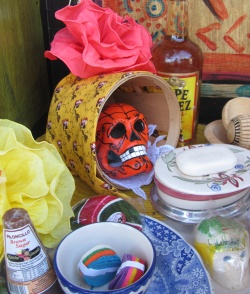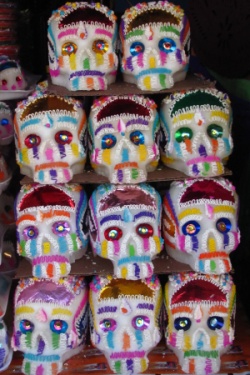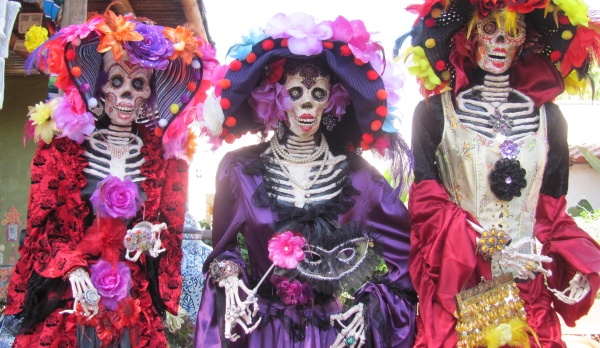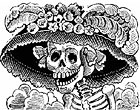|
|
Dia de los Muertos (Day of the Dead) is one of Mexico's most traditional holidays, combination of Aztec, Mayan and Catholic beliefs. On November 1st
(All Saint's Day) and 2nd (All Soul's Day) dead relatives, both young and old, are allowed to return to the mortal world for two days to visit loved ones. Below you will find a glossary of items and terms associated with the Day of the Dead plus a short description.
 Altars (altars) - Altars are set up in the families homes, businesses and the graves of the departed. They will clean, decorate and place ofrendas (offerings) on the departed one's grave or altar. Usually a photo and flowers are included. Candles are lit and set around the altar to guide the spirit home.
Calaveras (skulls) - People may wear skull masks or even artistically decorate their face in with paint.
Calaveras de Azucar (sugar skulls) - Kids will eat these, but most are meant for decoration in businesses, homes, and altars.
Dia de los Inocentes (Day of the Innocents) - This refers to the infants and children who have passed. They return on November 1st (All Saint's Day). It's sometimes referred to as Dia de los Angelitos (Day of the Little Angels).
Dia de los Muertos (Day of the Dead) - This refers the deceased adults when they return on November 2nd (All Soul's Day).
Marigolds (cempazuchitl in Spanish) - The official flower of Day of the Dead are thought to attract the spirits home. You will see vendors selling these orange flowers in the markets and families using them for decorations on altars and graves. Sometimes referred to as Flor de Muerto. Altars (altars) - Altars are set up in the families homes, businesses and the graves of the departed. They will clean, decorate and place ofrendas (offerings) on the departed one's grave or altar. Usually a photo and flowers are included. Candles are lit and set around the altar to guide the spirit home.
Calaveras (skulls) - People may wear skull masks or even artistically decorate their face in with paint.
Calaveras de Azucar (sugar skulls) - Kids will eat these, but most are meant for decoration in businesses, homes, and altars.
Dia de los Inocentes (Day of the Innocents) - This refers to the infants and children who have passed. They return on November 1st (All Saint's Day). It's sometimes referred to as Dia de los Angelitos (Day of the Little Angels).
Dia de los Muertos (Day of the Dead) - This refers the deceased adults when they return on November 2nd (All Soul's Day).
Marigolds (cempazuchitl in Spanish) - The official flower of Day of the Dead are thought to attract the spirits home. You will see vendors selling these orange flowers in the markets and families using them for decorations on altars and graves. Sometimes referred to as Flor de Muerto.
 Ofrendas (offerings) - Family and friends will decorate the altar/grave with items the deceased liked such as food, alcohol, and personal items.
Pan de Muerto (bread of the dead) - This traditional sweet bread is usually baked and offered for Day of the Dead. You can learn how to make Pan de Muerto here.
Papel Picado (punched paper) - These strings of Mexican paper art have their roots in both Aztec and Chinese tradition. Not
exclusively for day of the Dead you will also see these used for weddings and festivals. Intricate designs skulls, skeletons, flowers, etc. are cut into each piece. Ofrendas (offerings) - Family and friends will decorate the altar/grave with items the deceased liked such as food, alcohol, and personal items.
Pan de Muerto (bread of the dead) - This traditional sweet bread is usually baked and offered for Day of the Dead. You can learn how to make Pan de Muerto here.
Papel Picado (punched paper) - These strings of Mexican paper art have their roots in both Aztec and Chinese tradition. Not
exclusively for day of the Dead you will also see these used for weddings and festivals. Intricate designs skulls, skeletons, flowers, etc. are cut into each piece.
|

 Holiday Guide: Dia de los Muertos Holiday Guide: Dia de los Muertos
- Writer Marvin Perton shares the history and traditions of Dia de los Muertos, and where to find the best locations to participate or watch the real event.
 Day of the Dead - Oaxaca Comes Alive! Day of the Dead - Oaxaca Comes Alive!
- The tradition is alive in well in southern Mexico. Learn how the holiday is celebrated in the southern state of Oaxaca, with photos from the area.
 More on Oaxaca's Celebration of El Dia de Los Muertos More on Oaxaca's Celebration of El Dia de Los Muertos
- The Day of the Dead was once a very important religious holiday in Mexico. Over the years this holiday has been replaced by more commercial rituals such as those practiced on "Halloween" in the US. However traditional observances of Day of the Dead are still respected in southern Mexico, where indigenous customs and traditions are still very much alive.
 Happy Day of the Dead! Happy Day of the Dead!
- Thomas Whittingslow shares the history and event that honors the deceased loved ones in Mexico each year.
 A Day at El Panteon de Belen A Day at El Panteon de Belen
- The ghosts of Panteon de Belen, once a hospital cemetery, now a museum, walk the carefully manicured lawns...Story & photos by Hauquan Chau.
 Pan de Muerto - Highlighted Mexican Food Recipe Pan de Muerto - Highlighted Mexican Food Recipe
- Here we present the recipe for the traditional Pan de Muerto (Bread of the Dead).
 Your Oaxacan Day of the Dead Altar Your Oaxacan Day of the Dead Altar
- The Day of the Dead is an important family event, as such, the altar is usually set up in the biggest room in the house...Story and photos by Liz & Brian Parr
 |
|
Calavera Catrina | |
 Jose Guadalupe Posada Jose Guadalupe Posada
- Considered one of the founders of modern Mexican art. This artist's popular art prints depicting Calaveras (skeletons) offered graphic social commentary in the years leading up to and including the Revolution. Even today, the use of Calaveras in
cartoons or "staged" Day of the Dead altars offers pointed public mockery of our human weaknesses with the ever present inevitability of dead hovering in the background.
|